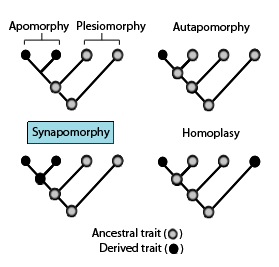Apomorphy and synapomorphy facts for kids
In phylogenetics, which is like studying the family tree of living things, an apomorphy is a new feature or trait that has evolved from an older, original form. Think of it as a brand-new upgrade!
A synapomorphy is a special kind of apomorphy. It's a new trait that is shared by two or more groups of animals or plants. Scientists believe this trait first appeared in their most recent common ancestor, which is like their shared great-great-grandparent. When we see a synapomorphy, it helps us understand how different species are related.
For example, mammals have several new traits that other vertebrate animals like amphibians or reptiles don't have. These include walking upright, having fur, having three tiny bones in their middle ear, and producing milk from mammary glands. These traits are apomorphies because they are new. They are also synapomorphies for mammals because all mammals share them, but other vertebrates don't. This tells us that these traits evolved in the common ancestor of all mammals.
Where Does the Word Come From?
The word "synapomorphy" was created by a German scientist named Willi Hennig. It comes from ancient Greek words:
- sún means "with" or "together."
- apó means "away from."
- morphḗ means "shape" or "form."
So, "synapomorphy" basically means a "new form together."
How Do Traits Help Us Understand Evolution?
Scientists use special terms to describe how traits are passed down or change over time in the evolutionary family tree. These terms help them figure out how different species are related.
- Symplesiomorphy or Plesiomorphy: This is an old, original trait that is shared by two or more groups. It's like a basic feature that hasn't changed much from their very distant ancestors.
- Reversal: Sometimes, a group might lose a new trait that its ancestors had and go back to having an older, original trait. It's like an evolutionary "undo" button.
- Convergence: This happens when two different groups of animals or plants independently evolve a similar trait, even though they don't share a recent common ancestor. For example, both birds and bats have wings, but their common ancestor didn't have wings. They evolved wings separately.
- Autapomorphy: This is a new, unique trait that is found only in one specific group or species. It's like a special feature that makes that group stand out from all others.
- Homoplasy: This is a general term for when a trait appears to be similar between different groups, but it didn't come from a common ancestor. This can happen through convergence (like the wings example) or reversal.
See also
 In Spanish: Sinapomorfia para niños
In Spanish: Sinapomorfia para niños


